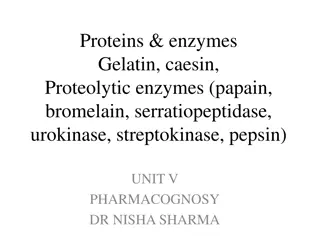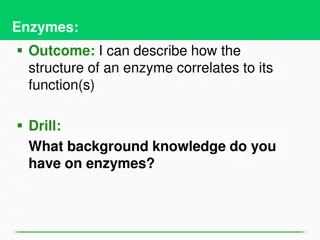Understanding Chloroplasts: Structure, Function, and Marker Enzymes
Chloroplasts are vital organelles in plant cells responsible for photosynthesis, converting light energy into chemical energy. They contain chlorophyll pigments for light absorption and play a crucial role in synthesizing foodstuffs. Marker enzymes such as RUBISCO, NADP-Reductase, and ATP synthase are essential for various metabolic reactions within chloroplasts. Their semi-autonomous nature allows for ATP and sugar synthesis through binary fission. Understanding the characteristics and functions of chloroplasts provides insights into their significance in plant biology.
Download Presentation

Please find below an Image/Link to download the presentation.
The content on the website is provided AS IS for your information and personal use only. It may not be sold, licensed, or shared on other websites without obtaining consent from the author. Download presentation by click this link. If you encounter any issues during the download, it is possible that the publisher has removed the file from their server.
E N D
Presentation Transcript
CHLOROPLAST Chloroplast, structure within the cells of plants and green algae that is the site of photosynthesis, the process by which light energy is converted to chemical energy, of oxygen and energy-rich Photosynthetic cyanobacteria are chloroplasts; endosymbiotic theory and mitochondria (energy-producing organelles in eukaryotic cells) are descended from such organisms. resulting in the production compounds. relatives chloroplasts organic free-living posits close that of
Characteristics of chloroplast Chloroplasts are a type of plastid a round, oval, or disk-shaped body that is involved in the synthesis and storage of foodstuffs. Chloroplasts are distinguished from other types of plastids by their green colour, which results from the presence of two pigments, chlorophyll a and chlorophyll b. A function of those pigments is to absorb light energy for the process of photosynthesis. Other pigments, such as carotenoids, are also present in chloroplasts and serve as accessory pigments, trapping solar energy and passing it to chlorophyll. In plants, chloroplasts occur in all green tissues, though they the parenchyma cells of the leaf mesophyll. are concentrated particularly in Chloroplasts are roughly 1 2 m (1 m = 0.001 mm) thick and 5 7 m in diameter. They are enclosed in a chloroplast envelope, which consists of a double membrane with outer and inner layers, between which is a gap called the intermembrane space. A third, internal membrane, extensively folded and characterized by the presence of closed disks (or thylakoids), is known as the thylakoid membrane.
Marker Enzyme of Chloroplast The marker enzymes of chloroplast include RUBISCO, NADP-Reductase, ATP synthase, Glyceraldehyde-3-phosphate dehydrogenase, and chlorophyllase etc. There are certain enzymes present in chloroplast some are known for their activity on photosynthesis while some are known for their action on different metabolism of plant 1. NADP-REDUCTASE - This enzyme is present in the grana thylakoid on the stroma side of chloroplast. This enzyme is helpful in light reaction of photosynthesis and is responsible for creating energy gradient in the chloroplast. 2. Phosphoenol pyruvate- This enzyme is present in mesophyll cell in C4-plants . It is important here to remember that this enzyme is not present in C3 plants. They only have Rubisco. In C4-plants PEP functions a primary CO2 acceptor and is responsible for fixation of PEP CARBOXYLASE. 3. PHOTOSYSTEM - II - An enzyme present in the thylakoid membrane which plays a major functions in non-cyclic photophosphorylation and is responsible for splitting of water to 2H+,[O] and electron. This electron is responsible for replacing those removed from photosystem I.
Semi-autonomous nature of chloroplast Chloroplasts are also semi-autonomous organelles found in plant cells and other photosynthetic eukaryotes. Chloroplasts use light energy to synthesize ATP and sugar molecules. Like mitochondria, chloroplasts reproduce by binary fission, but unlike mitochondria they have a three-membrane structure. In addition to an outer membrane and an inner membrane, chloroplasts also contain thylakoid membranes found inside the interior, or stroma, of the inner membrane. Like mitochondria, chloroplasts contain circular DNA and ribosomes, and are able to synthesize a number of the proteins that function within the organelle. In the lower left, we see an image of algal cells in which the chloroplast are readily visible due to the presence of light absorbing chlorophyll.
Composition of chloroplast Chloroplasts contain proteins, lipids, and chlorophyll, carotenoids, RNA and DNA. Starch granules or osmiophillic droplets are also present in it. chlorophyll b. These are found in green plants and algae. Chlorophyll is an asymmetrical molecule having a hydrophyllic head made of four pyrrole rings bound to each other to form a porphyrin ring. This part of the molecule is similar to haemoglobin and cytochromes. Proteins form a part of chloroplast membrane and lamellae, and are also present in the matrix in the form of enzymes. Lipids are mainly phospholipids, fats, sterols and waxes found in the lamellae and wall of the plastid. Chlorophyll is of two types-chlorophyll a and
In chlorophyll, however, there is a Mg atom forming a complex with four rings (In animal pigments the Mg is replaced by Fe).Chlorophyll has a long hydrophobic chain attached to one of the rings. In chlorophyll b there is a CHO group in place of the CH3group. Chlorophyll absorbs light mainly in the red region of the spectrum which causes the green colour of green plants. Chlorophyll molecules are disposed with in the thylakoid membrane in close association with integral proteins forming several complexes that have important functions in photosynthesis. Carbohydrates are found in a very low percentage and in chloroplasts the common carbohydrates are starch and sugar phosphates. DNA molecule in chloroplast was first of all reported by Ris and Plaut (1962) in Chlamydomonas (alga) and later it was reported in chloroplasts of other algae and higher plants. Chloroplast DNA resembles closely with bacterial DNA and differs from nuclear DNA in many respects. RNA is found in ribosomes of plastids. RNAs are of two types 24S rRNA and 16S rRNA. In chloroplasts are also found aminoacyl-tRNAs, aminoacyl-tRNA synthetases and methionyl-tRNA.























